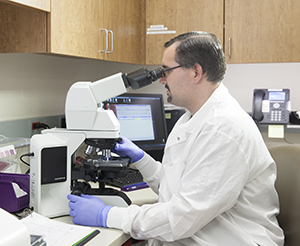A
B
C
D
E
F
G
H
I
J
K
L
M
N
O
P
Q
R
S
T
U
V
W
X
Y
Z
Back to Intro
Click a letter to see a list of medical procedures beginning with that letter.
Click 'Back to Intro' to return to the beginning of this section.
When Your Child Has Hematuria: Urologic Causes
When your child has blood in their urine, it's called hematuria. This can be scary to hear. But there are many reasons why hematuria occurs that are not serious. Your healthcare provider thinks a problem in your child’s urinary tract is causing hematuria. One or more tests are needed to figure out the exact cause. Once the cause is found, the problem can be treated or managed if needed.
There are two types of hematuria:
-
Gross hematuria. This means that blood can be seen when looking at the urine with the naked eye. The urine may look pinkish, brownish, or bright red.
-
Microscopic hematuria. This means that the urine looks clear, but blood cells can be seen when the urine is looked at under a microscope.
Both types may mean there is a problem somewhere in the body. But one is not more serious than the other.
 |
| With microscopic hematuria, blood cells can be seen when urine is looked at under a microscope. |
What are the possible causes of hematuria?
-
Runs in a family
-
Bladder or kidney infection
-
Recent “strep” (streptococcal) infection
-
Certain medicines
-
Vigorous exercise
-
Damage to the urinary tract or catheter use
-
Kidney stones
-
Blockage in the urinary tract
-
Diseases, such as sickle cell anemia
-
Kidney disease
How is hematuria diagnosed?
Your healthcare provider will ask you questions about your child’s health. A physical exam will also be done to look for problems. One or more of the following tests may be done to find the cause of your child’s hematuria:
-
Urinalysis. This checks the urine for blood or other problems.
-
Blood tests. These are done to look for infection or kidney disease.
-
Kidney and bladder ultrasound. These create images of the kidney and bladder using sound waves.
-
A KUB (kidney, ureter, bladder) X-ray. This is done to find out if your child has kidney stones or another problem.
-
CT scan. This gives the healthcare provider a more detailed image of the kidney and bladder than a regular X-ray.
-
Voiding cystourethrogram (VCUG). This is a type of X-ray imaging of the bladder and urinary tract. It uses a special type of X-ray called fluoroscopy and contrast material. It also shows how the bladder and urinary tract are working, especially during urination.
-
Cystoscopy. This test looks at and checks for bleeding inside the urethra, ureter, and bladder. It uses a small scope with a camera at the end.
How is hematuria treated?
Treatment depends on what’s causing the bleeding. Your child’s healthcare provider will discuss the cause of bleeding. They will also talk about the best possible treatment choices.
Online Medical Reviewer:
Marc Greenstein MD
Online Medical Reviewer:
Raymond Kent Turley BSN MSN RN
Online Medical Reviewer:
Rita Sather RN
Date Last Reviewed:
6/1/2022
© 2000-2025 The StayWell Company, LLC. All rights reserved. This information is not intended as a substitute for professional medical care. Always follow your healthcare professional's instructions.